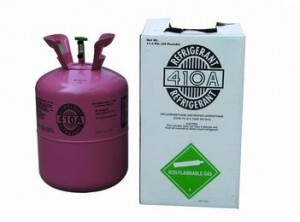 This credit, the final one in the Energy & Atmosphere section, is required for both the prescriptive and performance pathways, so we can begin accumulating more points again. The purpose of this credit is to both ensure proper air conditioning performance as well as minimize leakage of ozone-depleting refrigerants. According to the LEED for Homes Reference Manual, most refrigerants commonly used in HVAC equipment are stable chemical compounds that, when released to the environment, contribute to deterioration of the earth’s protective ozone layer and emit greenhouse gases. This seems like a pretty big deal! Other appliances, such as refrigerators, freezers, and wine coolers, also use refrigerants, but LEED does not address this anywhere in the point system. As my five-year old daughter once said, “If it’s bad for you, then why do they make that?” Indeed, that is the question.
This credit, the final one in the Energy & Atmosphere section, is required for both the prescriptive and performance pathways, so we can begin accumulating more points again. The purpose of this credit is to both ensure proper air conditioning performance as well as minimize leakage of ozone-depleting refrigerants. According to the LEED for Homes Reference Manual, most refrigerants commonly used in HVAC equipment are stable chemical compounds that, when released to the environment, contribute to deterioration of the earth’s protective ozone layer and emit greenhouse gases. This seems like a pretty big deal! Other appliances, such as refrigerators, freezers, and wine coolers, also use refrigerants, but LEED does not address this anywhere in the point system. As my five-year old daughter once said, “If it’s bad for you, then why do they make that?” Indeed, that is the question.
There are two components to this credit:
11.1 Refrigerant Charge Test is the prerequisite, in which we need to have a refrigerant charge test performed. I definitely had to ask our HVAC subcontractor about that. Refrigerant charge is the ratio of refrigerant required (pounds) to cooling capacity provided (tons) by a piece of installed cooling equipment. Apparently, many systems have incorrect refrigerant charge levels, which results in a reduction in durability, capacity, and efficiency of the cooling equipment. Who knew?
The second part, for one point, is 11.2 Appropriate HVAC Refrigerants. We would either have to (a) not use refrigerants at all (in many climates that would be possible), (b) use an HVAC system with non-HCFC refrigerants, or (c) have an HVAC system with a refrigerant that complies with a very complicated equation involving refrigerant leakage rates, end-of-life refrigerant loss, refrigerant charge, and equipment life.
Fortunately, our ground-source heat pump equipment, which both heats and cools our house (water-to-water for heating, and water-to-air for cooling), is factory-sealed so there is no refrigerant leakage and no way to perform a refrigerant test. Additionally, our system uses a refrigerant called R410a, which means we meet the requirement in (b) above and get one point. Per the LEED Manual, no calculations are needed for this credit if R410a is used. Lucky me! Really – this was pure luck, as I hadn’t known much about refrigerants (or even known to ask about them) when we were choosing our HVAC equipment. All I knew is that the ground-source heat pump would be extremely efficient, and my payback analysis showed it was the best option.
I am still curious about R410a, though. According to eHow.com,
The Clean Air Act of 1990 mandated a gradual phaseout of the R-22 refrigerant used in many cooling and heat pump systems. Testing deemed the R-410A refrigerant as a superior replacement for industry standards because of performance and energy efficiency. R-410A refrigerant was developed as an environmentally friendly and more efficient alternative to replace R-22 (Freon). R-410A refrigerant–also known as Puron–does not deplete the ozone the way R-22 does, but does have a higher global warming potential than the R-22 coolant.
So, when we were having ozone-depleting problems, we phased out Freon and introduced the “environmentally friendly” alternative that is worse for global warming. Is that true? I am not a scientist, but I have seen this confirmed in other articles about R410a. Because our system is factory-sealed, I guess I can assume that our system is not contributing to global warming? But the fact that LEED encourages this as a substitute is somewhat disturbing to me. Maybe global warming is not as bad as ozone depletion. Maybe there is no better substitute for air conditioning, and we humans will either have to live with environmental degradation or suffer in the summer. (As air conditioners have moved from luxury items to necessities, I am confident it will be the former.) Or, maybe we will find some “cure” for global warming and we can continue on our path of comfort and consumption.
On the plus side, I have read that R410a is a better refrigerant because it makes the air conditioning system more efficient, reducing the overall energy usage. Since energy usage does contribute to global warming, particularly in areas that are powered primarily by coal (like here in Minnesota), the tradeoff may be worth it. That makes me feel better about LEED promoting its use. And we do get one point here.
Total Energy & Atmosphere Points: 26.5
Cumulative points: 57.5
Additional points needed to get to Gold: 30.5
As a final note for this section, as I went through all the points available in the prescriptive path, we ended up with 21.5 points, 4 points less than we get in the performance path. Is hiring a green rater to model the HERS Index score worth the extra 4 points? It’s only a few hundred dollars, which is a rounding error in the overall cost of all the extra “green” items we paid for. So, yes – it’s a no-brainer.
